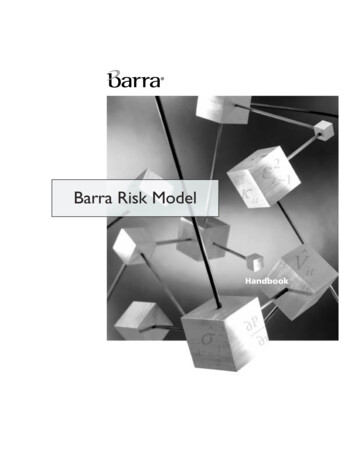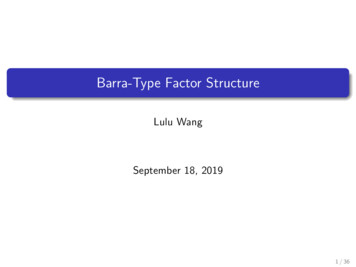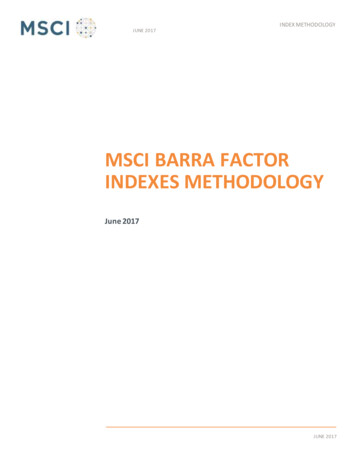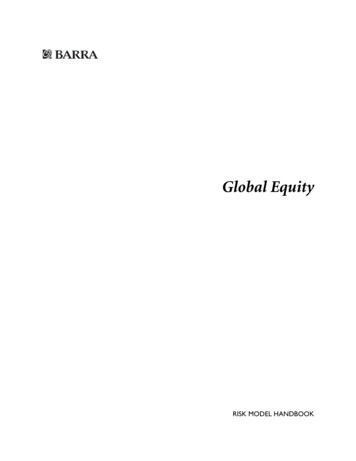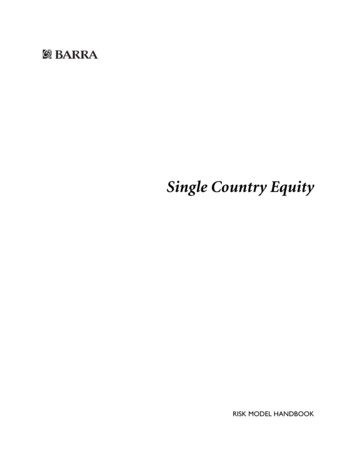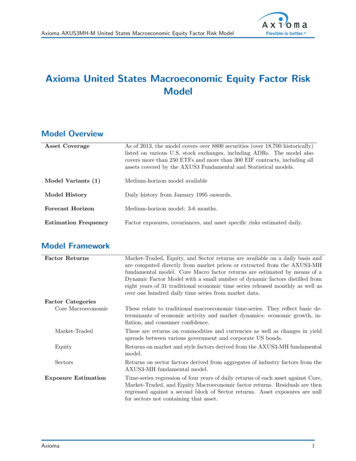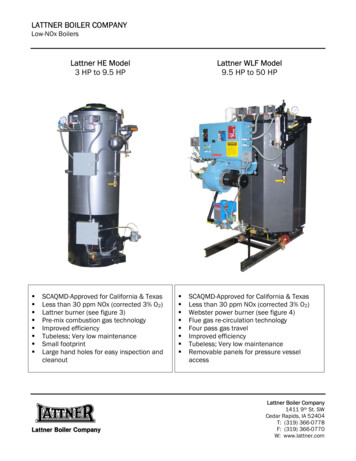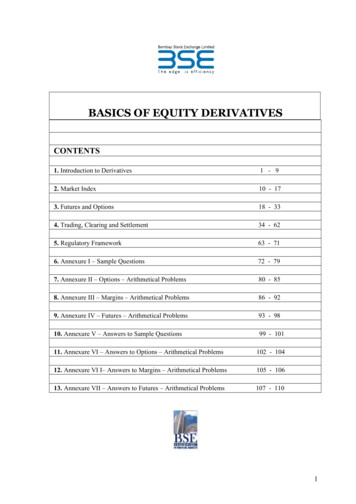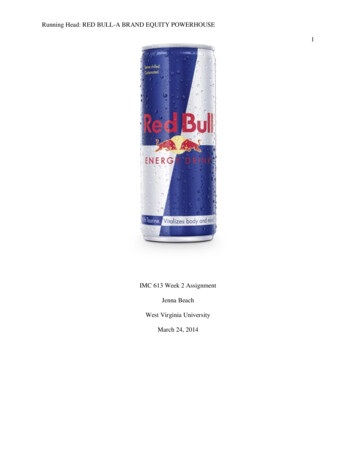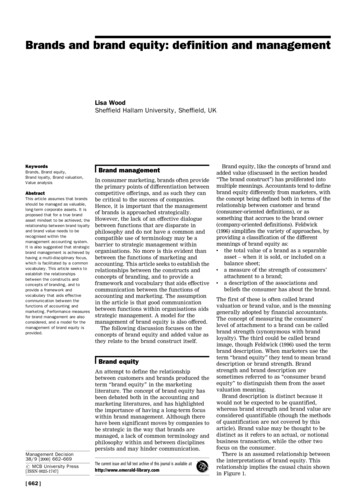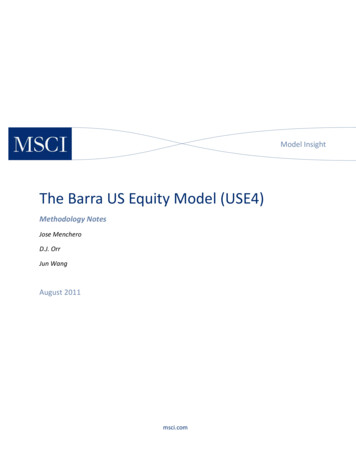
Transcription
Model InsightThe Barra US Equity Model (USE4)Methodology NotesJose MencheroD.J. OrrJun WangAugust 2011msci.com
Model InsightUSE4 MethodologyAugust 2011Contents1. Introduction . 31.1. Model Highlights .31.2. Modern Portfolio Theory and Barra Risk Models: A Brief History.31.3 Forecasting Portfolio Risk with Factor Models.62. Factor Exposures. 72.1 General Considerations.72.2. Data Quality and Outlier Treatment .82.3. Style Exposures.92.4. Industry Factors .92.5. Multiple-Industry Exposures. 103. Factor Returns . 133.1. Country Factor . 133.2. Relation to Traditional Approach . 154. Factor Covariance Matrix. 174.1 Established Methods. 174.2 Eigenfactor Risk Adjustment. 194.3 Volatility Regime Adjustment . 245. Specific Risk. 285.1 Established Methods. 285.2 Bayesian Shrinkage . 295.3 Volatility Regime Adjustment . 316. Conclusion . 35Appendix A: Review of Bias Statistics. 36A1. Single-Window Bias Statistics. 36A2. Rolling-Window Bias Statistics. 37Appendix B. Eigenfactor Risk Adjustment . 40REFERENCES . 43MSCI Research 2011 MSCI Inc. All rights reserved.Please refer to the disclaimer at the end of this documentmsci.com2 of 44RV May 2011
Model InsightUSE4 MethodologyAugust 20111. Introduction1.1. Model HighlightsThis document describes the new methodologies that underpin the USE4 model. Our aim is to produce adocument that is clear and concise, yet comprehensive as well. MSCI prides itself not only on setting thestandard for excellence in factor risk modeling, but also on being the industry leader in modeltransparency.This document is the complement to a companion document: USE4 Empirical Notes. Whereas thecurrent document focuses on methodology, the Empirical Notes contain detailed information aboutUSE4 factor structure, extensive analysis on the explanatory power and statistical significance of thefactors, and a systematic investigation into the forecasting accuracy of the model. The Empirical Notesalso provide a thorough comparison with the USE3 model.The main advances of USE4 are: An innovative Eigenfactor Risk Adjustment that improves risk forecasts for optimized portfolios byreducing the effects of sampling error on the factor covariance matrix A Volatility Regime Adjustment designed to calibrate factor volatilities and specific risk forecasts tocurrent market levels The introduction of a country factor to separate the pure industry effect from the overall market andprovide timelier correlation forecasts A new specific risk model based on daily asset-level specific returns A Bayesian adjustment technique to reduce specific risk biases due to sampling error A uniform responsiveness for factor and specific components, providing greater stability in sources ofportfolio risk A set of multiple industry exposures based on GICS An independent validation of production code through a double-blind development process toassure consistency and fidelity between research code and production code A daily update for all components of the modelThe USE4 model is offered in short-term (USE4S) and long-term (USE4L) versions. Both versions haveidentical factor exposures and factor returns, but differ in their factor covariance matrices and specificrisk forecasts. The USE4S model is designed to be more responsive and provide the most accurateforecasts at a monthly prediction horizon. The USE4L model is designed for longer-term investors whoare willing to trade some degree of accuracy for greater stability in risk forecasts.1.2. Modern Portfolio Theory and Barra Risk Models: A Brief HistoryThe pioneering work of Markowitz (1952) formally established the intrinsic tradeoff between risk andreturn. This paradigm provided the foundation upon which the modern theory of finance was built, andhas proven so resilient that it has survived essentially intact for nearly 60 years. Almost as remarkable isthe vigor with which the theory has been embraced by academics and practitioners alike.MSCI Research 2011 MSCI Inc. All rights reserved.Please refer to the disclaimer at the end of this documentmsci.com3 of 44RV May 2011
Model InsightUSE4 MethodologyAugust 2011The specific problem addressed by Markowitz was how to construct an efficient portfolio from acollection of risky assets. Markowitz defined an efficient portfolio as one that had the highest expectedreturn for a given level of risk, which he measured as standard deviation of portfolio returns. Markowitzshowed that the relevant risk of an asset is not its stand-alone volatility, but rather its contribution toportfolio risk. Thereafter, the concepts of risk and correlation became inseparable.A plot of expected return versus volatility for the set of all efficient portfolios maps out a curve known asthe efficient frontier. In order to construct the efficient frontier using the Markowitz prescription, aninvestor must provide expected returns and covariances for the universe of all investable assets. TheMarkowitz procedure identifies the optimal portfolio corresponding to the risk tolerance of any giveninvestor.Tobin (1958) took the Markowitz methodology and extended it in a very simple way that nonethelesshad profound implications for portfolio management. By including cash in the universe of investableassets, Tobin showed that there existed a single portfolio on the efficient frontier that, when combinedwith cash, dominated all other portfolios. For any investor, therefore, the optimal portfolio wouldalways consist of a combination of cash and the “super-efficient” portfolio. For instance, risk-averseinvestors may combine the super-efficient portfolio with a large cash position, whereas risk seekerswould borrow cash to purchase more of the super-efficient portfolio. As a result, according to Tobin, theoptimal investment strategy consists of two separate steps. The first is to determine the super-efficientportfolio. The second step is to determine the appropriate level of cash that matches the overall risktolerance of the investor. This two-step investment process came to be known as the Tobin separationtheorem.The next major step in the development of Capital Market Theory was due to Sharpe (1964). By makingcertain assumptions (e.g., that all investors followed mean-variance preferences and agreed on theexpected returns and covariances of all assets) Sharpe was able to show that the super-efficientportfolio was the market portfolio itself. Sharpe’s theory, known as the Capital Asset Pricing Model,predicts that the expected return of an asset depends only on the expected return of the market andthe beta of the asset relative to the market. In other words, within CAPM, the only “priced” factor is themarket factor.Using the CAPM framework, the return of any asset can be decomposed into a systematic componentthat is perfectly correlated with the market, and a residual component that is uncorrelated with themarket. The CAPM predicts that the expected value of the residual return is zero. This does not precludethe possibility, however, of correlations among the residual returns. That is, even under the CAPM, theremay be multiple sources of equity return co-movement, even if there is only one source of expectedreturn.Rosenberg (1974) was the first to develop multi-factor risk models to estimate the asset covariancematrix. This work was later extended by Rosenberg and Marathe (1975), who conducted a sweepingeconometric analysis of multi-factor models. The intuition behind these models is that there exists arelatively parsimonious set of pervasive factors that drive asset returns. Returns that cannot beexplained by the factors are deemed “stock specific” and are assumed to be uncorrelated.Rosenberg founded Barra, which made widespread use of multi-factor risk models and dedicated itselfto helping practitioners implement the theoretical insights of Markowitz, Tobin, Sharpe, and others. Thefirst multi-factor risk model for the US market, dubbed the Barra USE1 Model, was released in 1975.That model was followed by the USE2 Model in 1985, and USE3 in 1997. Rapidly changing volatilitylevels during and after the Internet Bubble highlighted the need for more responsive risk models, and in2002 the USE3 Model was upgraded to incorporate daily factor returns.MSCI Research 2011 MSCI Inc. All rights reserved.Please refer to the disclaimer at the end of this documentmsci.com4 of 44RV May 2011
Model InsightUSE4 MethodologyAugust 2011Another key step in developing the theoretical edifice of quantitative investing came with the publishingin 1995 of an influential book entitled Active Portfolio Management, written by Grinold and Kahn whileat Barra. The widespread success of this book prompted a second edition by Grinold and Kahn (2000),and it serves today as an essential guidebook for many quantitative investment firms.For modeling global portfolios, an important milestone came in 1989 with the development of the firstBarra Global Equity Risk Model (GEM). This model was estimated via monthly cross-sectional regressionsusing countries, industries, and styles as explanatory factors, as described by Grinold, Rudd, and Stefek(1989).GEM was followed by a second-generation Global Equity Risk Model, GEM2, as described by Menchero,Morozov, and Shepard (2008). GEM2 incorporated several advances over the previous model, such asimproved estimation techniques, higher-frequency observations, and the introduction of the Worldfactor to place countries and industries on an equal footing.Barra also pioneered the use of integrated models, which combine the breadth of a global model withthe detail of local single-country models. An innovative feature of this approach is that it assuresconsistency between the risk forecasts used by portfolio managers in the front office and risk managersin the middle office. The first-generation Barra Integrated Model (BIM) was introduced in 2002. Thesecond-generation Barra Integrated Model, described by Shepard (2011), incorporated importantadvances in methodology, such as using the GEM2 model to estimate covariances among local factorsand employing higher-frequency observations.Barra risk models have long played an important role in applying the concepts of modern portfoliotheory to solve practical investment problems. At MSCI, we are dedicated to continuing this proudtradition of developing industry-leading risk models. The release of the new Barra US Equity Model,USE4, marks only the latest step in this ongoing journey.MSCI Research 2011 MSCI Inc. All rights reserved.Please refer to the disclaimer at the end of this documentmsci.com5 of 44RV May 2011
Model InsightUSE4 MethodologyAugust 20111.3 Forecasting Portfolio Risk with Factor ModelsThe asset covariance matrix is critical both for portfolio construction and for risk management purposes.A key challenge in estimating the asset covariance matrix lies in the sheer dimensionality of theproblem. For instance, an active portfolio containing 2000 stocks requires more than two millionindependent elements. If the asset covariance matrix is computed naively — that is, by brute force —then the matrix is likely to be extremely ill-conditioned. This makes the asset covariance matrix highlysusceptible to noise and spurious relationships that are unlikely to persist out-of-sample. For instance, ifthe number of time observations is less than the number of stocks (as would be typical for largeportfolios), the matrix is said to be “rank deficient,” meaning that it is possible to construct apparentlyriskless portfolios.Factor risk models were developed to provide a more robust solution to this problem. Stock returns areattributed to a factor component that affects all stocks, and an idiosyncratic component that is uniqueto the particular stock. More specifically, the stock return is explained asrn X nk fk un ,(1.1)kwhere X nk is the exposure of stock n to factor k , f k is the return to the factor, and un is the stockspecific return.Consider a portfolio with weights wn , and return given byRP wn rn .(1.2)nThe portfolio factor exposures are given by the weighted average of the asset exposures, i.e.,X kP wn X nk .(1.3)nTherefore, the portfolio return can be expressed asRP X kP fk
Barra Global Equity Risk Model (GEM). This model was estimated via monthly cross-sectional regressions using countries, industries, and styles as explanatory factors, as described by Grinold, Rudd, and Stefek (1989). GEM was followed by a second-generation Global Equity Risk Model, GEM2, as described by Menchero, Morozov, and Shepard (2008). GEM2 incorporated several advances over

